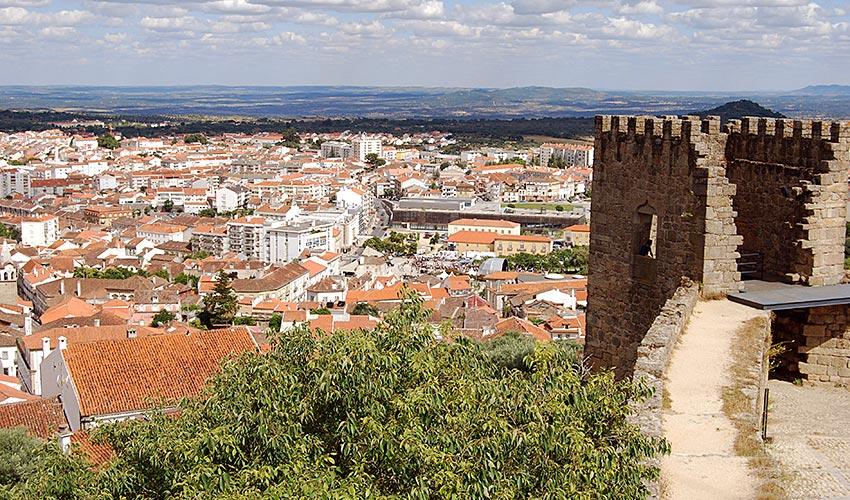The captivating district of Castelo Branco is an open-air museum enriched with magnificent vestiges of Portugal’s past and is home to some of the oldest traditions that characterise the country today.
Designated as the capital of the district, the city of Castelo Branco is internationally reputed for its intricate hand embroidery, regional cheese, olive oil and wine. Laying amongst the rural landscape of Central Portugal, this beautiful city exhibits typical architecture, century-old monuments and medieval churches – an eye-catching destination for curious travellers.
Monsanto is situated north of Castelo Branco and is commonly referred to as “the most Portuguese village in Portugal”. Traditional granite houses, narrow passageways and charming little gardens are some of the features that identify this quaint village. It is believed that the medieval Castle of Penamacor was given to the Templars during the 12th century and is a vivid example of the many frontier castles that once bordered the region. The peaceful Serra da Malcata and its nature reserve are located approximately 20 km from the castle and are home to some of the remaining specimens of the Iberian Lynx.
The Roman Centum Cellas Tower is one of Castelo Branco’s most intriguing national monuments and can be seen from the 13th century castle of Belmonte. Also known as “the gateway to Serra da Estrela”, Covilhã is one of the most important towns in the district for its historical role in the textile/wool industries in Portugal and Europe.
Serra da Estrela, Portugal’s highest mountain range (mainland) and its popular natural park are one of the most sought-after destinations in the country for its skiing resort, quaint villages and distinct artisan cheese. A part of Serra da Estrela is located in Castelo Branco, while the rest of its territory extends to Guarda.
Places to see
Serra da Estrela
Serra da Estrela is a big tourist attraction in the region for its beautiful natural park, skiing resort, historic villages and wonderful gastronomy.
Capela de Santa Cruz ( Covilhã)
Also known as the Capela do Calvário, this Gothic chapel was founded by Infante D. Henrique during the 15th century and was restored a century later by his son, Infante D. Luis. The ceiling is embellished with beautiful 20th century paintings that depict the life of Jesus Christ.
Igreja de Nossa Senhora da Conceição (Covilhã)
Although considered Gothic, this 16th century church displays a unique fusion of Baroque and Revivalist architectural influences. Its façade has a typical Gothic portal, while its interior boasts an elaborate stone-sculpted choir, as well as impressive 16th century tomb chapels.
Jardim do Paço Episcopal (Castelo Branco)
This splendid garden was created in 1725 at the request of the Bishop of Guarda, D. João de Mendonça. Lakes, fountains and elaborate staircases harmoniously blend into this pretty setting, making it a wonderful site to be seen. The Jardim Alagado, the ‘Flooded Garden’, is a beautifully stone-sculpted pond filled with flowers and plants, and has a lovely fountain in its centre. The garden’s most popular attraction is the Escadaria dos Reis, a staircase featuring numerous statues of Portuguese monarchs and noblemen. Several themes are represented throughout the garden, such as the Zodiac signs, the five parts of the World, the four seasons, the Evangelists, the Doctors of the Church and Apostles, amongst many others.
Santuário de Nossa Senhora de Mércoles (Castelo Branco)
Curiously, the origin of this chapel or when it was built is unknown. However, according to tradition, it is believed to have been constructed by the friars of the Templar Order. The tiles that adorn its interior have existed since 1609. A unique detail that characterises this chapel is its low floor level, reason why five steps have been integrated at the entrance.
Marquês da Graciosa Manor House (Idanha-a-Nova)
This property portrays a typical manor house and represents the lifestyle of the wealthier families that once lived in the region. Two floors, a garden, a
Many of these castles can be found throughout Idanha-a-Nova and were once military fortresses used to shield Portugal from Spain. Examples of these castles are spread throughout Idanha-a-Nova in places such as Monsanto, Penha Garcia, Salvaterra do Extremo, Segura and Rosmaninhal.
Frontier Castles (Idanha-a-Nova)
Many of these castles can be found throughout Idanha-a-Nova and were once military fortresses used to shield Portugal from Spain. Examples of these castles are spread throughout Idanha-a-Nova in places such as Monsanto, Penha Garcia, Salvaterra do Extremo, Segura and Rosmaninhal.

 English
English  Português
Português  Deutsch
Deutsch 



